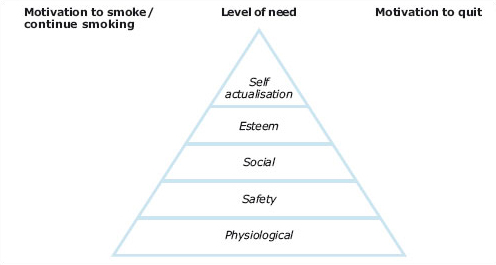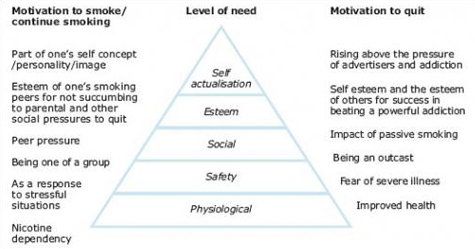3.3 The importance of understanding motivation
Personal characteristics in Figure 1 combine both psychological and personal factors. Two important factors which drive behaviour are motivation and attitudes.
MacFadyen et al. (1998) (see Figure 1) emphasise the role of goals, aspirations and symbolic needs. Many of you will be familiar with theories of motivation and how they explain why we engage in a particular behaviour in order to achieve our goals and satisfy our needs. There are many theories of motivation. You may have come across these in other studies of marketing, human resource management or elsewhere. Motivation theories seek to explain why we do the things we do either by examining how a behaviour satisfies our ‘needs’ or the processes we go through as we decide how to achieve our goals. One of the best known of motivation theories is that of Maslow's (1943) theory of human motivation or hierarchy of needs. The five original needs comprised those listed below and are illustrated in the typical hierarchical approach in Figure 2a.
Physiological needs: These are the basic needs of the organism such as food, water, oxygen and sleep. They also include the somewhat less basic needs such as sex or activity.
Safety needs: Here Maslow is talking about the need for a generally ordered existence in a stable environment which is relatively free of threats to the safety of a person's existence.
Social (love) needs: These are the need for affectionate relations with other individuals and the need for one to have a recognised place as a group member – the need to be accepted by one's peers.
Esteem needs: The need of a stable, firmly based self-evaluation. The need for self-respect, self-esteem, and for the esteem of others.
Self-actualisation needs: The need for self-fulfilment. The need to achieve one's full capacity for doing.

Activity 3
By reference to Maslow's hierarchy in Figure 2a, illustrate for each level of need why you think that young people (teenagers) are motivated to smoke, and why they might be motivated to quit.
Below is a printable version of the hierarchy diagram.
Click the link below to open Maslow's hierarchy.
Maslow's Hierarchy [Tip: hold Ctrl and click a link to open it in a new tab. (Hide tip)]
Discussion
In addition, money could be a motivator at various levels, e.g. spending money saved on family or friends (social needs) or to avoid debt (safety needs) or to achieve self esteem through purchase of an expensive mobile phone.

